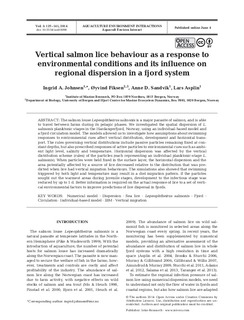| dc.contributor.author | Johnsen, Ingrid A. | |
| dc.contributor.author | Fiksen, Øyvind | |
| dc.contributor.author | Sandvik, Anne Dagrun | |
| dc.contributor.author | Asplin, Lars | |
| dc.date.accessioned | 2014-07-08T09:21:02Z | |
| dc.date.available | 2014-07-08T09:21:02Z | |
| dc.date.issued | 2014-06-04 | |
| dc.identifier.citation | Johnsen IA, Fiksen Ø, Sandvik AD, Asplin L (2014) Vertical salmon lice behaviour as a response to environmental conditions and its influence on regional dispersion in a fjord system. Aquacult Environ Interact 5:127-141 | nb_NO |
| dc.identifier.issn | 1869-215X | |
| dc.identifier.issn | 1869-7534 | |
| dc.identifier.uri | http://hdl.handle.net/11250/197241 | |
| dc.description.abstract | The salmon louse Lepeophtheirus salmonis is a major parasite of salmon, and is able to travel between farms during its pelagic phases. We investigated the spatial dispersion of L. salmonis planktonic stages in the Hardangerfjord, Norway, using an individual-based model and a fjord circulation model. The models allowed us to investigate how assumptions about swimming responses to environmental cues affect vertical distribution, development and horizontal transport. The rules governing vertical distributions include passive particles remaining fixed at constant depths, but also prescribed responses of active particles to environmental cues such as ambient light level, salinity and temperature. Horizontal dispersion was affected by the vertical distribution scheme (rules) of the particles (each representing an individual planktonic-stage L. salmonis). When particles were held fixed in the surface layer, the horizontal dispersion and the area potentially affected by a source of lice decreased relative to the distribution that was predicted when lice had vertical migration behaviours. The simulations also showed that swimming triggered by both light and temperature may result in a diel migration pattern. If the particles sought out the warmest areas during juvenile stages, development to the infectious stage was reduced by up to 1 d. Better information on the actual response lice have to a set of vertical environmental factors is needed to improve predictions of lice dispersal in fjords. | nb_NO |
| dc.language.iso | eng | nb_NO |
| dc.publisher | Inter-Research | nb_NO |
| dc.subject | VDP::Landbruks- og Fiskerifag: 900::Fiskerifag: 920::Fiskehelse: 923 | nb_NO |
| dc.title | Vertical salmon lice behaviour as a response to environmental conditions and its influence on regional dispersion in a fjord system | nb_NO |
| dc.type | Journal article | nb_NO |
| dc.type | Peer reviewed | nb_NO |
| dc.source.pagenumber | 127-141 | nb_NO |
| dc.source.volume | 5 | nb_NO |
| dc.source.journal | Aquaculture Environment Interactions | nb_NO |
| dc.source.issue | 2 | nb_NO |
| dc.identifier.doi | 10.3354/aei00098 | |
